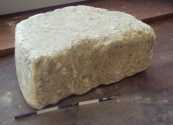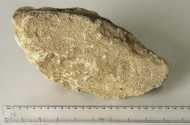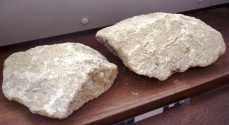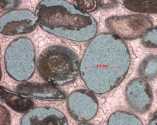


Left: C2083 worked masonry
Middle: C3297 worked stone
Right: Two pieces of worked masonry from C4649
The main objective of this report is to determine the petrology and (where possible) the geological source of the stone assemblage (excluding tesserae) collected from Room 6 of Period 2 Timber Building 2 during the 2004 excavation season. The late 1st/early 2nd century AD date assigned to this period makes identifying the likely source of the material all the more interesting. The function of the carved stone from this room is then considered. The early use elsewhere in the province of the 'freestone' identified here concludes the report. A catalogue of stone identifications accompanies this document.
Worked, burnt and unworked stone collected from Room 6 of Timber Building 2 amounted to 26 pieces from 5 contexts (Total weight 94.1kg). All pieces were examined in hand specimen using a hand lens (Gowland x10) in order to identify the type of rock in use. A large proportion (14 examples – 80.2kg) of this material was retained and examined in greater detail. Three rock samples, from the walls of Room 6 (2083), (3297) and (4649), were thin-sectioned (KH261, KH32, KH260) and then submitted to a series of mineralogical (X-Ray Diffraction) and geochemical (X-Ray Fluorescence, Stable Isotope Geochemistry (carbon and oxygen)) tests in order to determine their geological provenance. Comparison was made with the author's reference collection of thin sections and database of geochemical samples of British and Continental worked limestone, as well as 1st-century architectural fragments from London and Bath that had previously been prepared and sourced.



Left: C2083 worked masonry
Middle: C3297 worked stone
Right: Two pieces of worked masonry from C4649
Number of contexts 3; number of examples 5. Total weight 1.11kg.
Present, in small quantity, as rubble in the walls of Room 6 (3297) and (4649) and on the mortared floor (3700).
Soft, fine-grained, white, homogeneous limestone. No discernible fossils.
Upper Chalk Upper Cretaceous
Local material. Thick outcrops close by, with bedded flint, including at Mapledurwell in Hampshire (12km to the south) (Sellwood 1984; 1989).
Number of contexts 2; number of examples 2. Total weight 380g.
Present, with the chalk, as small nodules, in the walls of Room 6 (4649) and burnt on the mortared floor (3700).
Hard, dark grey/black siliceous sediment that fractures easily.
Upper Chalk Upper Cretaceous
Local material. Outcrops in bands of the Upper Chalk close by, including at Mapledurwell in Hampshire (12km to the south) (Sellwood 1984; 1989).
Number of contexts 4; number of examples total 21. Total weight 92.9kg. Retained 14. Total weight 80.2kg.
Present in large quantity, either as amorphous rubble or broken column fragments, along the walls of Room 6 (2083), (3284), (3297) and (4649).

Oolitic limestone thin section C4649
White (2.5YR 8/1) to Yellow/Brown (10YR 7/6) weathered limestone surface, with calcite vein 'watermarks' (Jope 1964) cutting across the sedimentary fabric. The latter consisted of alternating layers of bioclastic and rounded (oolitic) grains. Banded Shelly Oolitic Grainstone (Dunham 1962).
In thin-sections KH32 (3297) and KH261 (4649) (see above), the dominant calcite grain consisted of small (0.4mm) round ooids (65%) that had been weathered out. The bioclastic component (20-25%) in each had fragments of oyster. The fine ferroan microcrystalline calcite cement contained little or no quartz. Section KH260 (2083) was slightly different in that the ooids were on average larger (0.6mm), better formed and more dominant (80%).
Combe Down Oolite/Box Groundstone (Bathonian–Middle Jurassic South Cotswolds).
These freestones outcrop along the Middle Jurassic ridge in the Bath-Box region of Avon, approximately 90km from Silchester.
The worked and unworked limestone samples (KH32; KH260-261) from Room 6 of Timber Building 2 shared the following hand specimen, petrological and geochemical characteristics with a freestone sample of Combe Down Oolite (KH98).
Six architectural fragments of Combe Down Oolite (total weight 31.4kg) and one large, poorly worked block (47kg) were identified from the threshold and the walls of Room 6 (see Data Table). Their fragmentary, weathered state would infer that they had been used in an earlier masonry structure and broken up for subsequent reuse as walling material in Room 6. Included was a column fragment (4649) and a substantial piece of a column base (2083) (details). The column base had evidence for chisel tooling and a possible ‘Lewis Hole’, created to help lift the freestone block out of the quarry using pulleys. It has been possible to estimate the diameter of the column fragments (thanks to Klare Tootell) as 0.5m. The soft, even, fine-grained texture of oolitic limestone enables the rock to be worked in any direction (hence the term freestone) and embellished with decoration (some evidence of this is present in (2083)).
These are not the only examples of this type of stone to have been unearthed from Insula IX. Reworked architectural fragments were identified during the Victorian excavations of House 2 (Fox 1895, 443) and there is a row of at least five, reused, column fragments, which probably functioned as post-pads, to the south of the Period 2 Timber Building 3. They were exposed during the 2006 season. In hand specimen, these recent discoveries have an identical limestone texture to the material from Room 6 and are undoubtedly from the same quarry source
The origin of these fragments, however, remains unclear. Their reuse in large quantities as early as the late
1st/early 2nd century implies both the existence of a very early, substantial, masonry structure elsewhere at
Silchester, and its early demolition or part-demolition.
Architectural fragments from early public buildings at Silchester, including from the pre-Flavian Bath-house from Insula XXXIII (St John Hope and Fox 1905), and from the make-up layer above the Flavian (timber) Forum-Basilica (Fulford and Timby 2000) were sampled, and some of this material too was found to be petrologically and geochemically comparable with Combe Down Oolite (Note 1).
There is insufficient evidence to deduce the kind of building(s) from which the material was derived, whether temple, palatial town-house, bath-house, etc.
The stone assemblage identified from Room 6 of the Period 2 Timber Building 2 is quite different from that associated with Periods 3 and 4 of the 'House 1' sequence. The near exclusive use of reworked architectural fragments carved out of Combe Down Oolite from the Bath/Box region is in contrast to the use of flint, quernstones and tesserae in these later phases.
What this petrological study has also shown was that 'freestone' was actively being quarried and supplied to Silchester from Bath on a more extensive scale than has previously been supposed.
Other than Silchester, the early use of Combe Down Oolite has been identified in thin-section and geochemically (Hayward forthcoming) in column fragments reused in pre-Flavian levels of a possible mansio at Southwark (15-23 Southwark Street) (Cowan 1992, 14) and from fluted-column shafts and the Great Altar of the Temple of Sulis Minerva at Bath itself (Blagg 1979; Cunliffe and Davenport 1985). This shows that the earliest (pre-Flavian) demand for freestone at London and Silchester in public buildings of some pretension was being met in part by the quarries from the Bath region.
Petrological analysis of this Period 2 material and of other early architectural fragments and tombstones from south-east England (Hayward forthcoming) has already demonstrated that, from the outset, Roman surveyors, 'geologists', quarrymen and masons knew a great deal about the potential of the Bath outcrop, as well as others along the Middle Jurassic ridge, as a source of stone for fine decorative carving and inscription.
1 Results from Appendix 5.2 of the contributor's unpublished PhD thesis (Hayward 2006). The identification of Painswick Stone from Gloucestershire for the Silchester bath-house show that other materials were being used at Silchester at the same time.
© Internet Archaeology
URL: http://intarch.ac.uk/journal/issue21/4/finds_stone_link_room.htm
Last updated: Wed Sept 12 2007